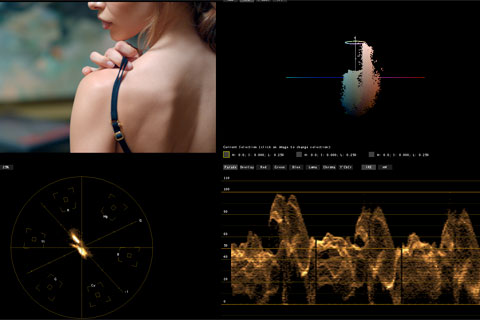Color correction has gone from being a technique handled by gurus who jealously guarded their secrets in dark rooms with priceless equipment to being within the reach of any filmmaker. However, the fact that color correction software has dropped in price does not mean that the discipline has changed and that anyone without previous knowledge knows what to do with it. Color correction techniques are still an independent discipline between post-production and cinematography. Knowing the basics of color grading, regardless of the software, and knowing how to apply these techniques to each particular production is what turns a simple software operator into a colorist.
This course will explain the basics of color correction, but also how to prepare a material from shooting to conforming, through offilne editing, thinking about the final color correction. Using simple but powerful tools such as Avid MC, Apple Color, Magic Bullet Looks or DaVinci Resolve, the workshop will show that color techniques go far beyond the mere “correction” that the term says, being able to improve or completely change the aesthetics of the production.
DURATION: 12 hours
TEACHER: Luis Ochoa.
He works as a colorist in Spain and in London for the London Film School. His credits include feature films (“Cecilia y Juan”, “Por la gracia de Luis”) and television (“Tierra de Lobos”). He has also worked as a post-production manager on numerous projects for Avid Technology and is an ACI (Avid Certified Instructor).
SOFTWARE: Avid Media Composer 6, Apple Color 1.5, Magic Bullet Looks, DaVinci Resolve 8 on Apple Professional Workstations (one per student)
AIMED AT: Avid and FCP editors, directors of photography, digital image technicians, producers, filmmakers…
PREVIOUS KNOWLEDGE: Familiarity with the concepts of SD and HD video signal. Basic photographic knowledge.
PRICE: 260€. With the possibility of the “amigo promotion” and other discounts.
WHEN: July 14 and 15, 2012. Saturday from 16 to 20h and Sunday from 10 to 14 and 15:30 to 19:30h (times may vary slightly).
WHERE: Ondas Escolares. See in Google Maps. If you need any kind of information you can contact 709 MR by email or phone (668840783).
COURSE CODE: CC29-140712
GENERAL OBJECTIVES:
- Understand the overall post-production process and the place of color correction in it.
- Learn the technical basis of color correction regardless of the tool used.
- Learn the philosophy and methodology of color correction work with common color correction software.
- Understand the differences between the software used, in order to choose the most suitable for each project.
CONTENTS
- Comparison of photochemical and digital color correction. Concept of primary, secondary and mask color corrections.
- Digital intermediate concepts: 2K and 4K resolutions. DPX files and telecines.
- Offline-online digital conforming. HD resolutions. Conforming process. DNxHD and uncompressed codecs. Transcoded. Sampling and bit depth. RAW Media
- Concept of gamma In cinema (film sensitometric curves.), professional video and computers. Color spaces RGB, 709, XYZ…
- Logarithmic and linear gamma curves. Correction and preview luts.
- DI and broadcast calibration: Luts and densitometers, conversion between color spaces.
- Manual calibration: When and how.
- Monitor characteristics: resolution, connections, dynamic range, dominants, bit depth, gammuts…
- Use of measuring instruments: waveforms, vectorscope, histograms, parade.
- Apple Color color corrector. Explanation of the different rooms
- Work process in color correction. Steps to follow and correction of common problems.
- Composition applied to correction: masks, chromas, lumas and/or secondaries.
- Dynamic corrections. Animation of corrections.
- Editing complementing editing: Avid Media Composer and Avid Symphony
- Magic Bullet Looks: Explanation of the Avid and FCp7 plugin for look creation
- DaVinci Resolve: An introduction to Blackmagic’s advanced color correction tool.
- Render types and qualities. Final rendering. Processing bits
You can download the documentation to take the course here
For more information and to reserve a place, please send an e-mail to info@709mediaroom.com.


